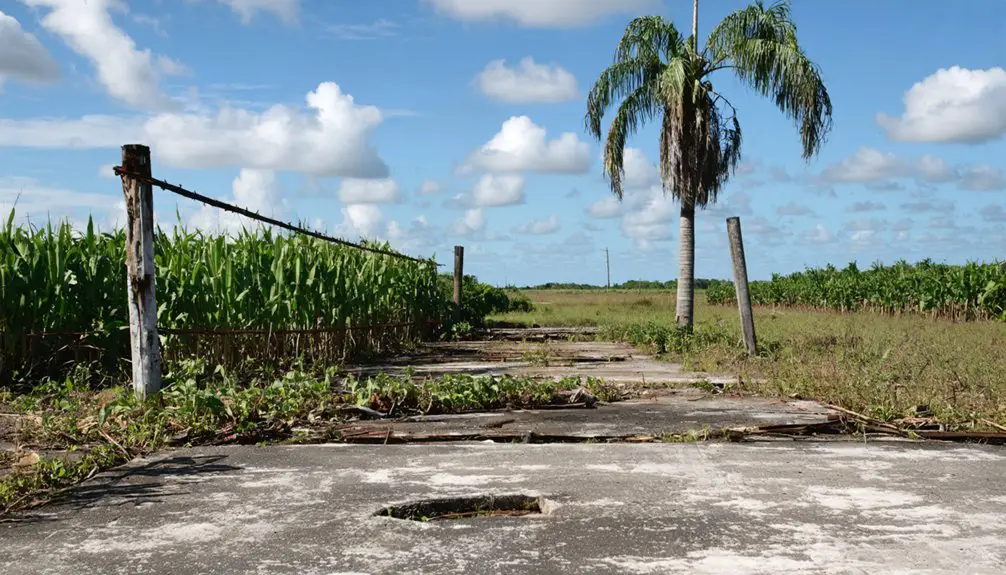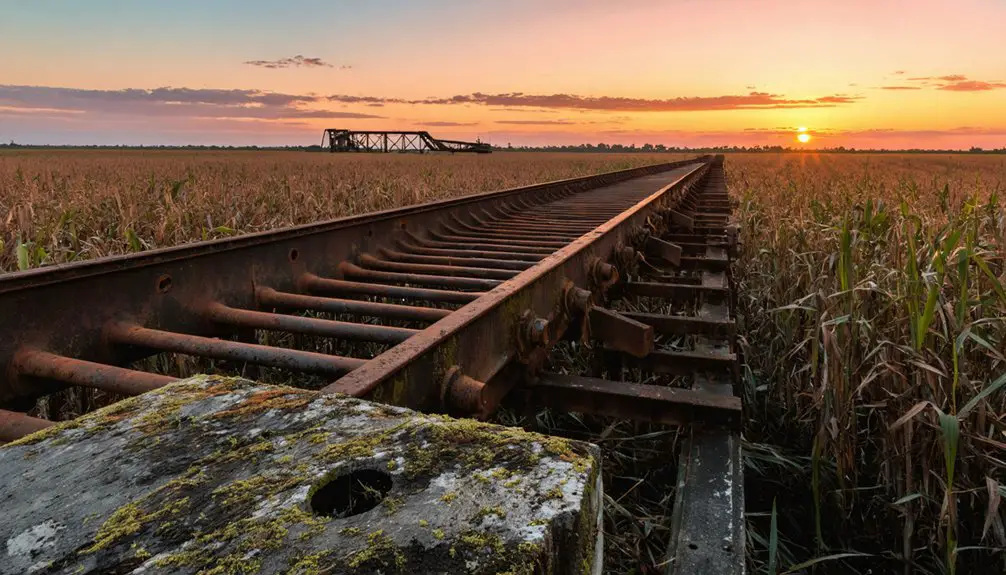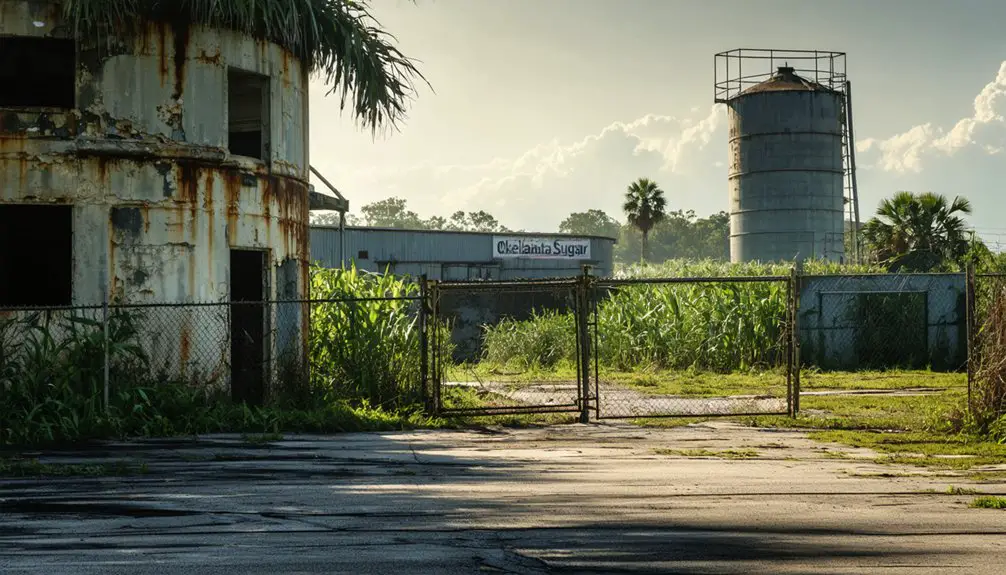You’ll find Okeelanta’s remains near modern-day South Bay, Florida, where a sugar mill now stands. This pioneering community, founded in 1913 by Thomas Will, grew from swampland into a thriving agricultural settlement of 200 residents by 1920. The town boasted schools, farms, and innovative drainage systems until the catastrophic 1928 Okeechobee hurricane destroyed nearly everything. Today, while the original town has vanished, its story reveals fascinating lessons about Florida’s frontier ambitions.
Key Takeaways
- Okeelanta was established in 1913 as a planned agricultural community in Florida’s Everglades, reaching 200 residents by 1920.
- The community thrived with diverse crop farming until the devastating 1928 Okeechobee hurricane destroyed nearly all structures and infrastructure.
- After the hurricane caused $50 million in damages, Okeelanta was abandoned and the Okeelanta Corporation went bankrupt.
- No visible remnants of the original town exist today, with the site now occupied by sugar processing facilities and sugarcane fields.
- The ghost town’s history demonstrates the challenges of developing Everglades wetlands and the impact of natural disasters on pioneer settlements.
The Birth of an Everglades Dream (1913)
In 1913, Thomas Will initiated an ambitious venture by establishing Okeelanta, a planned community spanning nearly 900 acres of Everglades swampland. The settlement’s name cleverly combined “Okeechobee” and “Atlantic,” reflecting its strategic location between these major bodies of water.
You’ll find that Will’s vision went beyond mere land development. Through the newly formed Okeelanta Corporation, he set out to prove that Florida’s challenging Everglades could be transformed into productive farmland.
The community quickly embraced diverse crops including Irish potatoes, corn, beans, tomatoes, and eggplant. By 1920, you could’ve found yourself among roughly 200 residents who called this agricultural experiment home. The town established a school and town hall to serve its growing population.
Despite the wild animals, mosquitoes, and persistent flooding that threatened their progress, these pioneers were determined to turn their agricultural hopes into reality. Though the original community faded by the 1920s, it laid the groundwork for what would become a sugar empire in Florida’s agricultural landscape.
Early Pioneers and Settlement Vision
While Thomas Will spearheaded Okeelanta’s founding, several other notable pioneers helped establish this ambitious Everglades settlement. R.A. Little, S.A. Hughes, Herman Walker, and Lawrence Will joined forces to transform untamed sawgrass marshes into productive farmland. The success of early agricultural practices made Okeelanta the largest Everglades community by 1917. Sadly, the town’s prosperity was cut short when a devastating hurricane completely destroyed it in 1928.
You’ll find their settler resilience reflected in how they tackled the harsh environment, establishing a thriving community of 110 families by 1917.
- Built essential infrastructure including a hotel and town hall
- Experimented with agricultural innovation through soil amendments
- Created a self-sufficient economy with lumberyards and blacksmiths
- Named the settlement by combining “Okeechobee” and “Atlantic”
- Proved farming viability through diverse crops like sugarcane and tomatoes
Their vision wasn’t just about farming – it was about creating a model agricultural community that would demonstrate the potential of Florida’s interior wetlands.
Agricultural Ventures in the Wetlands
As pioneers transformed the Everglades into farmland in the early 1900s, massive drainage projects carved five major canals from the Atlantic coast to Lake Okeechobee. Each mile of canal drained roughly 900 acres, setting the stage for agricultural innovation in the region.
You’d have found the first farms on Ritta and Torry Islands by 1904, where settlers cleared pond apple forests to plant vegetables, sugar cane, bananas, and citrus. The promise of cheap, fertile farmland drew worldwide attention from 1905-1928. The historic town was established by Laurence E. Wills’ father before being destroyed in the devastating 1928 hurricane. The area’s famous rich muck soil came from decomposed custard apple trees that once dominated the landscape.
While this development sparked economic growth, the environmental impact was substantial. The drainage caused muck soils to subside and burn, creating the “land of a thousand smokes.”
The drainage of Florida’s wetlands transformed fertile soil into smoldering earth, earning the region its ominous nickname.
Water hyacinths, introduced as cattle feed, spread uncontrollably through canals, disrupting essential transportation routes until control measures were implemented.
Life in a Frontier Community
Life in Okeelanta took shape around a tight-knit community of 110 families by 1917, growing to 200 residents by 1920.
You’d find the essence of frontier resilience in the town’s basic but functional infrastructure, including a school, town hall, and essential businesses. Community dynamics centered around shared challenges and collaborative efforts to tame the wilderness. The town’s name cleverly combined Okeechobee and Atlantic, reflecting its strategic location between these two water bodies. Similar to the complex structures of Florida’s ancient tribes, the settlers established organized systems for community governance.
- You’d start your day dealing with mosquitoes and wild animals while tending to crops.
- You’d rely on the local blacksmith and lumberyard for your farming and building needs.
- You’d gather at the hotel or barber shop to exchange news and socialize.
- You’d participate in canal digging projects to drain the Everglades.
- You’d attend town hall meetings to voice your opinion on road development and infrastructure.
The community’s determination to transform swampland into productive farmland shaped daily life, requiring adaptability and self-reliance.
The Great Hurricane’s Devastating Impact
September 1928 brought catastrophic devastation to Okeelanta when the Okeechobee hurricane struck Florida with unprecedented force.
You’d have witnessed floodwaters rising 25mm per minute as Lake Okeechobee’s dikes failed, releasing a 120km-wide surge that swept away homes, crops, and lives.
The hurricane aftermath was staggering – nearly all structures were destroyed except for a single house.
The powerful hurricane, moving in from the Caribbean, made landfall as a Category 4 storm.
Despite the community’s resilience, Okeelanta couldn’t recover. Sustained winds exceeding 100 mph battered the region relentlessly.
The town’s agricultural foundation, including potato fields, corn crops, and vegetable farms, was obliterated.
The flooding destroyed essential infrastructure, from canals to roads, while claiming many lives.
With $50 million in damages and the Okeelanta Corporation’s bankruptcy, this once-thriving frontier community of 200 residents was abandoned, marking the end of a promising settlement.
Economic Struggles and Abandonment
Before its ultimate downfall, Okeelanta’s economy had shown early promise through its agricultural ventures and planned development. The community’s initial resilience was evident in its growth to 200 residents by 1920, with established infrastructure and agricultural operations shipping produce northward.
- Early investors like R.A. Little and S.A. Hughes helped establish a thriving farming community.
- Environmental challenges, including floods and mosquito infestations, steadily eroded economic stability.
- The Florida land boom briefly sparked interest but couldn’t sustain long-term growth.
- Infrastructure investments of $450,000 came too late to prevent economic decline.
- The 1928 hurricane delivered the final blow, leading to Okeelanta Corporation’s bankruptcy.
You’ll find that despite determined reconstruction efforts by Thomas Will, the combination of natural disasters and depleted resources ultimately forced the community’s abandonment.
What Remains: Modern-Day Site

Today you’ll find no visible remnants of the original Okeelanta town, with only a large sugar processing plant marking the general vicinity of where this community once stood.
The site, located near the intersection of US27 and 827 Hillsboro Canal Road in Palm Beach County, is now surrounded by vast sugarcane fields that dominate the landscape.
You won’t find any historical markers or dedicated access points to explore the ghost town‘s location, as the area has been fully integrated into the region’s agricultural operations.
Physical Site Today
Although Okeelanta once thrived as a pioneering agricultural settlement, the modern site reveals no physical traces of its former existence.
You’ll find no site remnants or historical markers to indicate where buildings once stood, as natural disasters and time have erased all visible evidence of the town. Instead, the landscape has transformed into vast sugarcane fields, dominated by a nearby processing plant.
- The original town grid and infrastructure have completely disappeared
- No standing structures remain from the original settlement
- Access is limited to local roads like US27 and Hillsboro Canal Road
- The environment reflects typical reclaimed Everglades farmland
- The site functions purely as agricultural land with no tourist amenities
The harsh climate and flooding have guaranteed that Okeelanta exists now only in historical records and local memory.
Agricultural Industry Presence
The agricultural powerhouse of Okeelanta Corporation dominates the former ghost town’s landscape, operating 67,000 acres of sugarcane fields alongside an integrated sugar processing complex.
You’ll find a complete sugar production system here, from farming to milling, refining, packaging, and distribution – all evidence of the area’s agricultural evolution from its humble beginnings.
While the original 1913 farming settlement was destroyed by the 1928 hurricane, the land found new purpose through sugar industry expansion.
Today, the Okeelanta Sugar Mill stands as the centerpiece of this vast agricultural empire, processing tons of sugarcane from surrounding fields.
The site’s transformation mirrors Florida’s broader shift toward industrial-scale sugar production, particularly after the Cuban revolution sparked major growth in the region’s sugar operations.
Modern visitors seeking Okeelanta’s ghost town location will find their primary access point at the junction of US Route 27 and Palm Beach County Route 827.
Your ghost town navigation will be limited by the lack of paved roads leading to the original townsite, which now lies within private agricultural land.
- You’ll need to use the Okeelanta sugar processing plant as your main landmark for orientation.
- Access routes are affected by seasonal flooding and wet conditions, particularly during rainy months.
- The flat Everglades terrain offers few natural markers to guide your exploration.
- You won’t find historical markers or interpretive signs at the site.
- The intersection of US 27 and County Road 827 serves as your primary GPS reference point for planning visits.
Legacy in Florida’s Sugar Industry

Following Cuba’s 1959 revolution and subsequent 1961 trade embargo, Florida’s sugar industry experienced unprecedented growth as Cuban sugar imports to America ceased.
You’ll find the Fanjul legacy deeply intertwined with this sugar expansion, as these Cuban exile sugar magnates brought their expertise to Florida’s shores. Within just three years, Florida’s sugarcane acreage jumped from 55,000 to 140,000 acres, while annual raw sugar production surged from 150,000 to 400,000 tons.
The Fanjuls’ strategic acquisitions, including Okeelanta Sugar Refinery in 1984, transformed the landscape. Through Florida Crystals Corp., they’ve built one of the world’s largest specialty sugar facilities, managing 67,000 acres of sugarcane.
Their innovative approach to mill operations and commitment to modernization has secured Florida’s position in the global sugar market.
Environmental Lessons From the Past
When you look at Okeelanta’s early failures, you’ll find nature sent clear warnings through subsiding muck soils, burning peat, and fish population collapses.
You can see how the destruction of wetlands and native ecosystems near Lake Okeechobee created a cascade of environmental problems, from clogged waterways to toxic algae blooms.
These historical missteps underscore the critical importance of preserving wetlands as natural flood barriers, water filters, and wildlife habitats.
Nature’s Warning Signs
The tragic fate of Okeelanta stands as a stark environmental cautionary tale from the early 20th century. Nature’s resilience proved stronger than human ambition when settlers attempted to transform dense wetlands into farmland. Environmental mismanagement led to devastating consequences, culminating in the town’s destruction during the 1928 Lake Okeechobee Hurricane.
- Early settlers ignored natural flood patterns and ecosystem dynamics
- Attempts to control wetlands through drainage proved unsustainable
- Recurring floods, freezes, and hurricanes undermined settlement stability
- Rapid vegetation regrowth after abandonment showed nature’s power
- The ghost town now serves as a monument to ecological limits
You’ll find that Okeelanta’s story teaches us vital lessons about respecting natural boundaries. When you try to dominate rather than work with environmental systems, nature often responds with devastating clarity.
Wetland Preservation Matters
Okeelanta’s disappearance sparked a broader understanding of wetland preservation’s importance in Florida’s environmental history.
You’ll find that early conservationists like May Mann Jennings fought against aggressive drainage while others pushed to transform wetlands into farmland.
Today’s wetland conservation efforts draw directly from these historical lessons. You can see the impact in projects that aim to restore natural water flows by filling drainage channels like the C-38 canal.
Modern ecological restoration combines strategic property acquisition with careful canal modifications, protecting both wildlife and flood control needs.
You’re witnessing a crucial shift as restoration projects work to reestablish natural hydrology, revive floodplains, and improve water quality.
GIS mapping now guides preservation efforts, ensuring remaining wetlands don’t share Okeelanta’s fate.
Connected Stories of Lost Florida Towns
Among Florida’s vanished pioneer settlements, Okeelanta shares a compelling narrative with several other lost towns that met similar fates in Palm Beach County during the early 20th century.
You’ll find these communities’ stories intertwined with themes of community resilience and historical memory, as they struggled against nature’s fury and economic hardships.
- Bryant housed workers for Southern Sugar Company before its decline
- Oak Lawn’s resort dreams faded as urban development took over
- Port Mayaca became a solemn burial ground after the 1928 hurricane
- These towns faced similar environmental and financial challenges
- Their collective story illustrates the fragile nature of pioneer ventures
Each lost town represents a chapter in Florida’s development, where ambitious settlers tried to tame the Everglades but ultimately succumbed to natural forces and economic realities.
Frequently Asked Questions
Were There Any Notable Crimes or Law Enforcement Issues in Okeelanta?
You won’t find documented crime statistics or law enforcement issues – historical records show no notable criminal activity during the town’s brief existence before its destruction by hurricane in 1928.
What Types of Wildlife Posed the Biggest Threats to Okeelanta Residents?
You’d have faced serious risks from alligator encounters in wetland areas and venomous snake sightings, while Florida panthers posed threats to livestock and mosquitoes spread dangerous diseases throughout the region.
Did Any Famous People Ever Visit or Stay in Okeelanta?
You won’t find any records of famous visitors or celebrity sightings in Okeelanta. The remote farming settlement’s brief existence focused on agriculture, attracting pioneers and workers rather than notable personalities.
What Was the Average Property Value of Homes in Okeelanta?
Picture a pioneer’s dream home vanishing into history – you won’t find exact property appraisals from Okeelanta’s heyday. The housing market there peaked during the 1920s Florida boom before collapsing completely.
Were There Any Churches or Religious Gatherings in the Community?
You won’t find records of formal churches in the town’s church history, though it’s likely residents held informal community gatherings for worship, possibly in homes or other buildings during 1913-1928.
References
- https://www.ghosttowns.com/states/fl/okeelanta.html
- https://palmbeachpast.org/2011/03/palm-beach-countys-lost-towns-the-complete-list/
- https://stories.simplyioa.com/the-top-6-ghost-towns-in-florida
- http://www.gribblenation.org/2018/08/ghost-town-tuesday-ghost-towns-of-lake.html
- https://www.urbancoroner.com/okeelanta
- http://wikimapia.org/7568087/Okeelanta-ghost-town
- https://blog.gilbertintl.com/okeelanta-corporation
- https://findingaids.uflib.ufl.edu/repositories/2/top_containers/14766?page=2
- https://en.wikipedia.org/wiki/Okeelanta
- https://pbchistory.org/a-story-of-agriculture/



